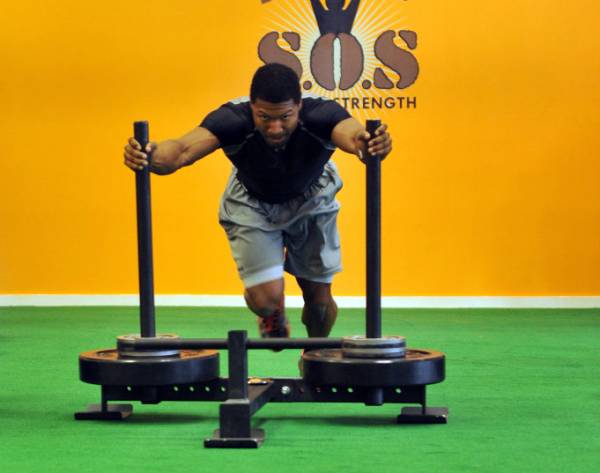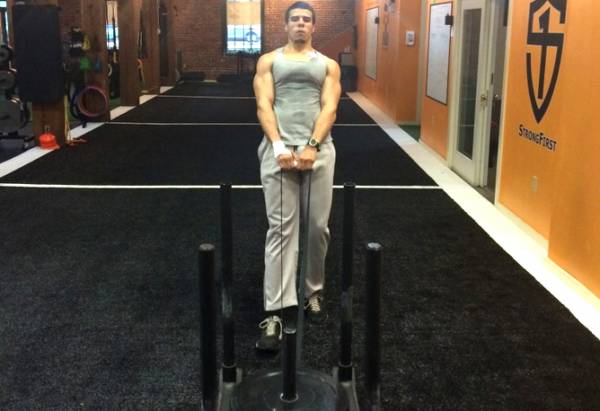Last week, I discussed energy systems with Mike Perry, from the Skill of Strength. This week, we will use our knowledge of energy systems to discuss how to condition MMA fighters. The training protocols discussed below are valuable for anyone who has unpredictability in their sport or work. We will help you get past being a “first round hero” so you can have energy in your later rounds.
One of the most important pieces I have learned from speaking with Mike is that you don’t always train as you fight. Designing your training based on the length of your rounds is important, but it is not the only way to train. In fact, if we can build the other energy systems, we will make the conditions of the fight seem even easier.
Squeezing the Glycolytic Window
Recently, I also spoke with Peter Park, who is Lance Armstrong’s strength and conditioning coach, about Lance’s offseason conditioning. He discussed building the alactic system and the aerobic system to “squeeze” the glycolytic window. This means much of Lance’s training was done below a specific heart rate to avoid involving the glycolytic system.
“We can’t forget that we have three energy systems and we need to train all three. By enlarging the capacity of the two outer systems, we don’t tax our glycolytic system as much.”
Part of the reason to squeeze the glycolytic system is to reduce neuroendocrine stress. In the long term, neuroendocrine stress causes adaptations that may break down the body. One reason we see short-term success in high-intensity gylcolytic programs might be stress-related weight loss. The stress hormones can stimulate fuel consumption in the short term. But in the long term, stress hormones can lead to breakdown in mitochondria. For long-term success, we want to shrink the time we use the gylcolytic system. We want to save it for competition or competition prep.
Thus, the goal of our offseason training is to:
- Help develop the alactic system (i.e., get stronger) and…
- Become more efficient at replenishing ATP through aerobic conditioning.
Prerequisites for Training the Energy Systems
One prerequisites to train the energy systems in the manner described below is that people have a general level of conditioning. Mike Perry tests all athletes with an all-effort one-minute cycling test. In this test, a strange anomaly occurs with many fighters in that they can’t pedal long enough to reach a max heart rate. Mike explained:
You would assume that if someone’s going all out on a bike for a minute that they’d probably get pretty darn close to maxing their heart rate out. Every once in a while what will happen is we’ll have them do that assessment and at about the twenty-second mark, their legs are gone. They can’t pedal anymore and they can’t even drive their heart rate any higher than maybe 150… They start pedaling and their legs just go. They have very poor lower-body muscular endurance and that’s a limiting factor in training their cardiovascular system.
Right there it tells me, we’re not going to be able to go into this really in depth energy system program. We just need to get them stronger. We’ll spend the first month literally hitting the basics. Deadlifting, squatting, split squat, all that stuff. We do a lot of work with long duration, (slow) sled pushes, long duration sled push drags. Often times we’ll work them up to eight to ten minutes straight of doing that. Where they’re really working a lot of time under tension, but it allows us to get the eliminating factor out of the way. Initially when they started it was lower-body muscular endurance. Their legs just gave out and then we really couldn’t train their cardiovascular system whether we wanted to. A lot of times we have to take that off the table, then we can really start to train and do their energy system work. That happens more often than you would think.

Phase One: Alactic and Aerobic Work
In an ideal situation, Mike starts his training with focus on alactic and aerobic work. I say ideal, because many times, fighters will come to him only five weeks before their fight. In those situations, he just crams in as much energy work as possible.
In phase one, strength and conditioning training is composed of three main activities:
1. Strength training – Strength training is emphasized in all phases as an adjunct to training, but not the end goal.
2. Short sprints followed by long rests – The temptation for many people who try this type of training is to shorten rest intervals. We are led to believe we need to suffer for success. But in this type of training, we need to avoid the glycolytic burn. Push for only a short interval (alactic) and then rest. This allows our aerobic system to replenish the ATP. A six-to-one rest-to-work ratio usually fits. Feeling the burn and working through it is not in this phase of training. Be repetitively explosive with these drills.
3. Aerobic conditioning – We build our aerobic conditioning in this phase. Keep your heart rate to a level where you are not tapping into gylcolytic training. There are complex heart rate formulas to figure out your maximum heart rate, but a simple one is to take your age and subtract it from 180. I like to use the simple “talk test.” You should be able to hold a conversation while you do this type of aerobic conditioning.
Here is how Mike describes this phase:
Phase one would be focusing some alactic power and some aerobic work. Maybe we do some sled pushes that are six to eight seconds in duration. We’re going to rest for maybe sixty to eighty seconds and do repeats. We’re working on just getting them repetitively explosive. At the same time at the tail end of that workout we’re going to do some aerobic based stuff. Maybe they’re going to do a circuit where they’re keeping their heart rate from anywhere from one thirty five to one fifty five. They may be doing rope slams or bike sprints or whatever that may be. We always try to pair them up. We start off with a lot of alactic and aerobic work.
Phase Two: Gycolytic Capacity
Working the alactic and aerobic systems is ideal for most people, and unless your sport or job demands it, it is probably best to train phase one templates most of the time. So, most of us won’t venture into this second phase. Phase two is only for pre-competition and competition time periods. In this phase, you will work the glycolytic system and push its capacity. In Mike’s words:
As we progress we will add in more alactic capacity work. Once they develop that base, then we’ll get into lactic power and then lactic capacity down the road. That’s really the template that we use. We rarely introduce lactic power and lactic capacity right away because it’s pretty miserable stuff. What I’ve found is we’ve got this continuum. We’ve got your lactic power work which is … Let’s just say it’s sub eight seconds. Got your capacity work which is maybe eight to fifteen seconds. Depending on the athlete we may just continue up that time scale. Maybe they’re going lactic at the fifteen to eighteen second mark. Who knows? We know that a lot of the research says lactic power is anywhere from twenty to fifty seconds, etc. From what I’ve found it’s a basic continuum. If you work on their alactic capacity, eventually you’re going to get into their lactic power. You’re going to try to work their lactic power for as long as you can, then into lactic capacity. The biggie is really just taking your time and not destroying them. Making sure that when you are doing power work, you’re being repetitively explosive with whatever you’re doing. Whether it’s a sprint. Whether it’s a sled push. Whether it’s battling rope slams. Whether it’s bike sprints, whatever. We want to make sure that we’re getting their power work in, then their capacity second and then we just move onto the next system.
We do their lactic system and finish up the alactic capacity work. You have to be careful with the amount of total volume that you throw at them because they’ll burn out really quickly. … For example, if you dive right into lactic power work for example, without doing any alactic work and without having a good aerobic base. After about three weeks we noticed that they can just no longer go anymore. We just noticed that we get a plateau in their performance. We just don’t get that same power up, but hopefully over time we’re slowly getting jumps in power up if we’re doing things right.
One thing that I’ve noticed and the mistake that I’ve made to be quite honest is that if you go and you try to do high intensity work all the time, too early, without having a good aerobic base, they end up just stalling at the three to four week mark. We have to often times go back and clean up the mess of not doing the aerobics stuff first. It’s really easy to burn these guys out and they’ll get tired. They’ll just be exhausted all the time so you really have to be smart with the amount of volume that you throw at them.

Conditioning and Skill Development
One important component of conditioning work is to combine it with skill development as much as possible. Most MMA fighters are already doing some conditioning as they practice skill development. Mike’s job is often to fill in the gaps of their conditioning. In other sports, conditioning can be a big part of skill development. Mike explained:
You can do a boatload of skill development in an aerobic setting. For example, a soccer, lacrosse, or whatever field athlete. You can do acceleration drills. You can do multi-directional movement. You can do jump training. You can do landing, etc. That can all be done in an aerobic window that is not in a super non fatiguing environment, but will allow young athletes to acquire skills. It’s sort of in an aerobic setting.
As you start to increase their proficiency in movement, you can start to say, “Okay now we’re going to take this drill, we’re going to do this sprint for eight seconds and then we’re going to recover slowly.” We’ll guess what? That’s an alactic power template, but it’s also going to help with your speed. I think that there’s a way that you can take the energy system stuff and teach people how to develop athlete skill set.
Summary
Many new athletes train using intervals that are similar to the fight. For example, doing a “Fight Gone Bad” CrossFit-style protocol. However, building the alactic and aerobic base before pushing the glycolytic system works more effectively in the long run. We can’t forget that we have three energy systems and we need to train all three. By enlarging the capacity of the two outer systems, we don’t tax our glycolytic system as much. Relying too much on the glycolytic energy systems leads to neuroendocrine stress. In the long-term, too much neuroendocrine stress can cause cellular damage.
By following these protocols, you can go from a “first round hero” with nothing left in the tank to the person with your hand in the air at the end of a long bout.
More Like This:
- Conditioning for Fighting with Mike Perry, Part I: Energy Systems 101
- Why Does BJJ Make Me So Tired?
- Energy System Optimization With Joel Jamieson
- New on Breaking Muscle Today
Photos courtesy of Skill of Strength.






